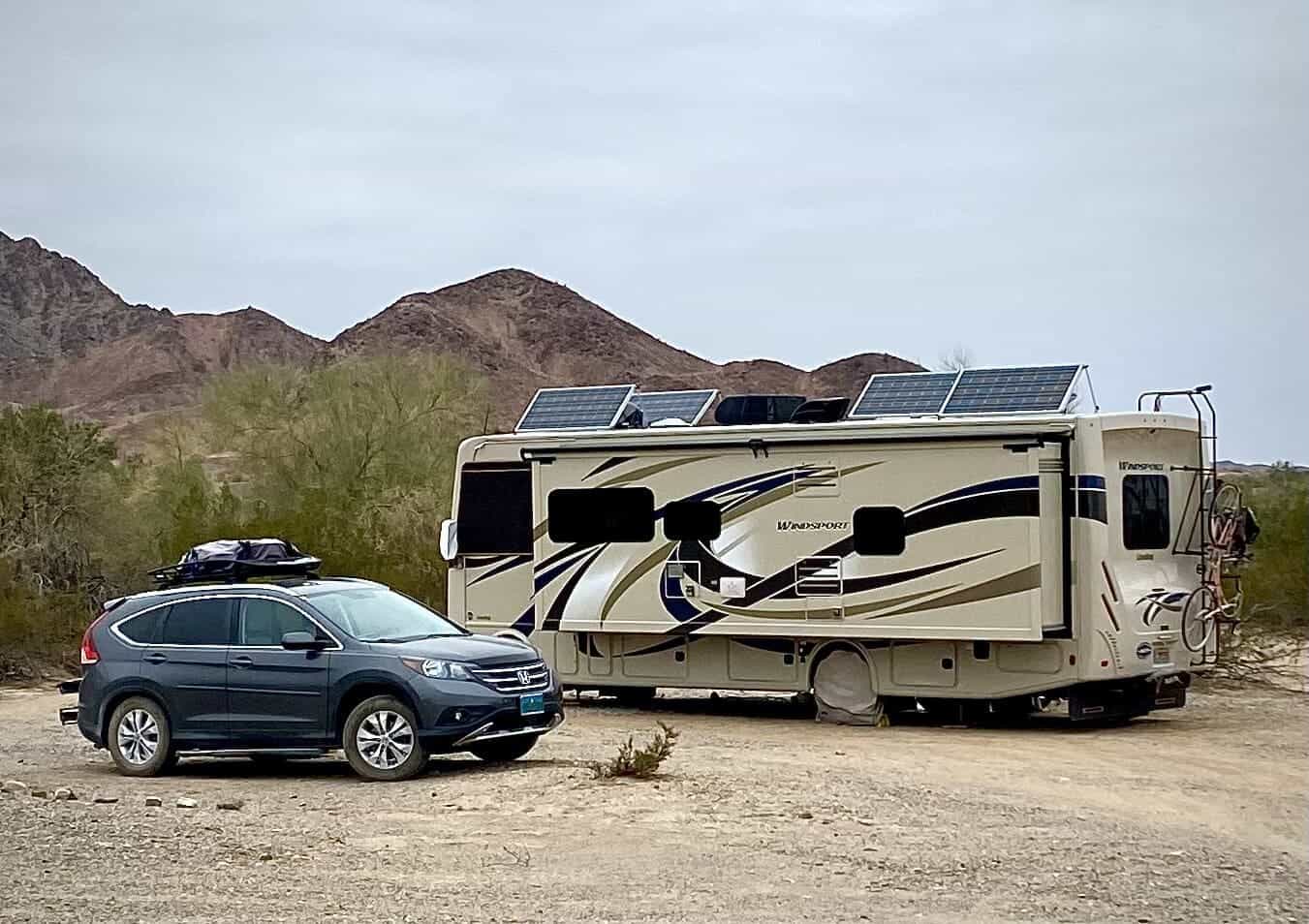Spring is a great time for us to de-winterize our RV in preparation for the upcoming summer camping season. And it’s also a good time to clean the RV holding tank system that makes up your septic and freshwater system, including the holding tank, and water lines. Get this RV plumbing maintenance done and your tank sensors should work better too.
Do the Dirty Job First: A Step-by-Step Guide to Cleaning Your RV Septic System
Let’s start with the dirty job of deep cleaning your RV septic system. It’s not exactly the same kind of septic for a residential house, because it’s not designed for waste to sit and break down. But if you do it regularly you can avoid common RV plumbing problems like clogged valves. Here’s how to give a decent clean to your holding tanks.
Gather Holding Tank Cleaning Supplies
Before you start, gather what you need to clean your RV holding tank and sewer lines:
- Disposable gloves
- Sewer hose (aka the “stinky slinky”)
- Sewer hose support or ramp
- Purchase a black tank cleaning wand, a tank rinser elbow adapter and RV-specific tank cleaner or enzyme treatment for best results.
- Safety goggles. Don’t skip them. They protect against bacteria entering your eyes due to errant sprays up through the toilet from the wand.
Park your motorhome or trailer in a suitable location where you can access a sewer dump station. Make sure the area is level to ensure proper draining or raise the low side with the RVs jacks or pull up on blocks to assure adequate flow.
Empty the Holding Tanks
Now wait. Allow both tanks to completely drain.
Flush the Tanks
You will know your holding tanks are clean when clear water appears. This indicates the tanks are empty of solid waste and the water can be shut off.
Add RV Tank Cleaner or Enzyme Treatment
Once the tanks are empty, rinsed and hoses put away, add RV-specific tank cleaner or enzyme treatment to each tank according to the manufacturer’s instructions. These products help break down waste and control odors inside the tanks.
DIY Holding Tank Cleaner Recipe
To make a DIY RV tank cleaner, the folks at Tank Kleen recommend a simple mixture of the following:
- Calgon bath beads (a water softener)
- Pine-Sol.
Similar to the more well-known “Geo Method” tank cleaner many RVers swear by, the Calgon water softener “breaks the surface tension of water in the tank, preventing anything from sticking to tank surfaces and sensors,” says Tank Kleen. The Pine-Sol disinfects and deodorizes your tanks. You can even put 1/2 cup in your gray water tanks to keep them in good shape.
Here’s how to make the DIY holding tank cleaner:
- Take an empty gallon (128 ounce) container. Add in 40 ounces (5 cups) of Pine-Sol (or something similar, like Pine Power). Pour in 4 ounces (1/2 cup) of Calgon.
- Fill the gallon bottle or jug with water. Go slow, it will bubble and foam. Once the bubbles are settled, shake it thoroughly.
- Pour in 1/2 to one cup of this mixture into your black tank as part of this maintenance process.
Fill Your RV Grey and Black Tanks with Water
After adding the tank cleaner or enzyme treatment, fill tanks with enough gallons of water to cover the bottom of each tank a couple of inches deep.
Can’t gauge the depth of water in your holding tank? Add a fourth of the known capacity of the tank. As an example, add 10 gallons of water to a 40-gallon gray tank.
Drive and Agitate
Now it’s time to agitate the tank cleaner or enzyme treatment and help it break down waste.
- Take a short drive with the RV. The movement will help slosh the water around inside the tanks, aiding in the cleaning process.
Can’t drive the RV? You can use an RV tank rinsing wand under pressure to agitate just the black tank.
Let the RV Tank Treatment Sit
Allow the tank cleaner or enzyme treatment to sit in the tanks for several hours or overnight, as recommended by the manufacturer. This gives the product time to work effectively allowing it to break down any remaining waste and odors.
Dump Your Tanks a Second Time
Once the treatment has had time to work, return to a dump station and empty the tanks again.
- Open the black water tank valve first.
- Now open the gray water tank valve. Ensure all contents are properly emptied.
Rinse Sewer Hose and Equipment
After emptying the tanks, rinse the sewer hose, hose support or ramp, and any other equipment used in the dumping process with clean water. This helps prevent odors and keeps the equipment clean for future use.
Stick to this Regular Maintenance
To maintain a clean and odor-free RV septic system, it’s essential to perform regular RV tank maintenance. This includes emptying and cleaning the black and grey water tanks as needed, using tank treatments regularly, and following proper dumping procedures.
If the above steps fail to adequately clean your septic system consider hiring a professional cleaning service.
Since having this done, I have flushed my tanks three times, and the process seems to go more quickly, & the flow more quickly becomes that of almost clear water!
@jabber_jaw, iRV2 Forums member
How to Spring Clean Your RV Water Lines and Freshwater Tank.
Now it’s time to get your RV water lines and freshwater tank clean and ready for the camping season. Start your spring cleaning process by making sure your RV is parked in a suitable location. Look for a level or semi-level surface. You will need easy access to potable water and proper drainage facilities as to not create a large puddle.
Empty the Freshwater Tank
Drain any remaining water from the freshwater tank by opening the water drains. Valves are typically located underneath the RV.
- Make sure the tank is completely empty before proceeding. Close the drain valve when you are sure the tank is completely empty.
Add a Tank Cleaner
Mix your cleaning solution. Use a mixture of water and RV-specific water line cleaner, or a diluted bleach mixture.
- Most RVers consider a cup of bleach to be the gold standard for cleaning and sanitizing their freshwater system. Details for cleaning your freshwater system with bleach can be found here.
- Other RVers desiring less harsh chemicals to clean the RV’s fresh water tank can use water tank/line cleaners such as Spring Fresh. This Camco product advertises it will treat up to a 100-gallon water tank, with no mixing required. You can use it for de-winterizing to clean and deodorize fresh water tanks. When using any cleaner, always follow the manufacturer’s instructions for the correct dilution ratio.
Now add the proper amount of cleaning solution into your freshwater tank. Use a funnel if necessary to avoid spillage.
Fill the Fresh Water Tank
Turn on the RV Water Pump
Turn on the RV water pump to pressurize the system. This allows the cleaning solution to flow from the freshwater tanks through the water lines.
Open Faucets and Fixtures
Open all RV faucets, including hot and cold taps, shower heads, outside shower and any other water fixtures inside the RV. This allows the cleaning solution to flow through the entire freshwater system.
Flush the Water Lines
Drain the Water System
Rinse the Water System
Do a Final Fresh Water System Check
Once you’ve completed the cleaning and sanitizing process, perform a final check of all faucets and fixtures to ensure there are no leaks or issues with the water system. This is as important as the actual process to clean RV septic and water lines.
Now Go Camping!
By following these steps and performing regular maintenance, you can keep your RV’s septic system along with the fresh water system clean. Your drinking water should be odor-free, too. Clean RV septic and water lines are essential for a more pleasant camping experience.




